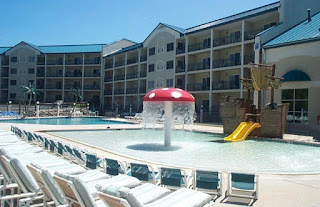 |
| The Lion Monument (Lowen Platz) |
Our tour coordinator told us that generally Swiss People are peaceful and tradition-respecting people who do not converse and mix with strangers easily. He also informed that the name of the city "Lucerne"(originally appeared as Luciaria in written records in 840 A.D.) came from that of the Benedictine Monastery of St. Leodegar founded here in 730 A.D. Later we went to see the famous Lion Monument in the small park located near Lowenplatz (Lion Square). The sculpture of a dying lion was hewn from the face of a sandstone rock commemorating the bravery and heroic struggle of the Swiss guards who sacrificed their lives to protect the French king Louis XVI during an attack by revolutionaries on Tuileries Palace in 1792. The sculptor expressed the majestic and undying bravery of the wounded lion in lying position with arrows pierced into its strong muscular body. In the park there is a pond surrounded by garden. The wrinkles on its face conveyed a sense of agony coupled with death-defying noble dignity. The inscription in Latin "Helvetiorune Fidei Ac Virtuti" (To the loyalty and bravery of the Swiss" was seen on the top of the monument. Nearly 760 Swiss mercenary soldiers lost their lives. This life-like monument was designed by a Danish sculptor, Thorvaldsen and was executed in sandstone by Lucas Ahorn, a German stone-mason from Southern Germany. This marvellous monument is 20 feet in height and 10 feet in length. Mark Twain, the famous American writer, described this monument as "the saddest and most moving piece of rock in the world."
 |
| Casagrande, the gift shop, Lucerne |
 |
| Interior View of Casagrande |
In the market place there are many shops and restaurant. We went to "Casagrande", a shop where one can buy gift items, Swiss chocolates and souvenirs. We bought a Swiss knife (a multi-purpose tool with many blades), a few pens and key chains.Wherever we went, we found our countrymen working as helpers in sale counters. As Lucerne is a tourist destination, people can understand English and we did not face any problem. Though the currency of Swiss is Swiss Franks, Euros are accepted everywhere.
 |
| Business Park Hotel, Geneva |
Thus ended our first phase of our day's journey as we have to reach Geneva by evening where we are going to stay and spend one night. To save time our tour manager organized a short trip through Geneva city i.e. a sort of city orientation tour before releasing us from hectic schedule to rest our limbs in the cosy hotel "Business Park Hotel" after having our Indian dinner. It would have been better if we had been introduced to some of the native Swiss dishes, of course, with the option given for both veggies and non-veggies.
************************************************************







































